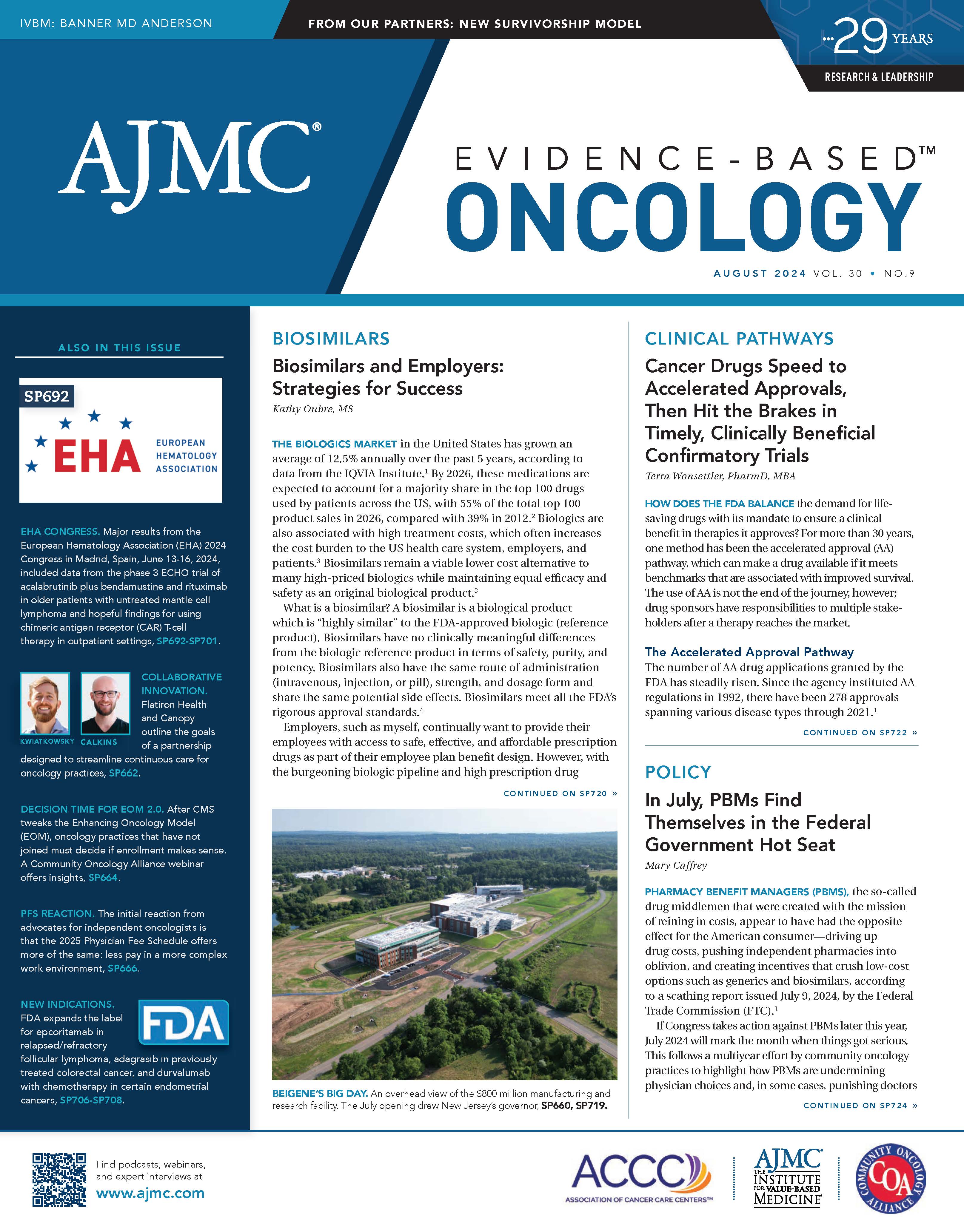- Center on Health Equity & Access
- Clinical
- Health Care Cost
- Health Care Delivery
- Insurance
- Policy
- Technology
- Value-Based Care
Collaborative Innovation: Flatiron Health and Canopy Partner to Streamline Continuous Care for Oncology Practices
Before discussing words such as technology, innovation, or interoperability, we’d like to talk about the lives of the patients we serve. The following is a story of a patient receiving cancer care in the community setting. We encounter stories like this every day:
Lavi Kwiatkowsky | Image: Canopy

Michelle* is a 34-year-old mother who recently achieved remission following therapy for breast cancer. Within a month of believing her treatment was over, she started experiencing persistent headaches like none she’d had in the past. She didn’t want to worry her husband, nor was she excited to return to the doctor’s office for more treatment. She was done. But when the headaches became so strong that she couldn’t sleep, her husband took a firm stance: “You have to call your doctor’s office.” Michelle said, “No.”
Geoff Calkins | Image: Canopy

Her husband continued to push. He knew Michelle had access to the Canopy patient app, which helps patients communicate issues and requests with their care teams without calling the practice. Even though her treatment was finished, the app was still accessible. As a compromise, she agreed to use it and reported a mild headache with a distress score of 5. At the practice, given Michelle’s breast cancer diagnosis, algorithms within the Canopy platform immediately alerted her nurse to the possibility that the cancer had spread to Michelle’s brain. She was urgently brought in for imaging, and upon confirmation of a brain metastasis, she went on to receive radiation therapy.
Thanks to the effective monitoring and the diligent care provided by the practice, Michelle eventually achieved a second remission. Had she waited longer, it might have been too late.
Michelle’s experience highlights a critical gap in cancer care. When most people think of cancer treatment, they focus on what occurs during office visits when patients see clinicians or receive therapies. However, in reality, most cancer care occurs outside the clinic, beyond the watchful eyes of a patient’s care team. Much of a patient’s journey is spent between visits, navigating a complex health care system, dealing with financial stress, and fighting an array of symptoms created not only by the cancer but also the cancer treatments themselves. When patients can communicate these issues to their care teams between visits and the care team can support them promptly, patient outcomes dramatically improve. Findings from randomized controlled trials show that patients with metastatic cancer receiving proactive symptom monitoring and management demonstrated longer treatment persistence, fewer visits to the emergency department, higher quality of life, and a 20% increase in overall survival.1,2 Follow-up studies conducted by Canopy and others have aimed to replicate these clinical findings and demonstrate how the model can be operationalized in clinical practice.3
For all these reasons, continuous care management—proactively managing patients’ issues between visits—is fast becoming a staple of modern cancer care. CMS has also recognized the importance of continuous care, making electronic patient-reported outcomes (ePROs) an important component of the newly expanded Enhancing Oncology Model (EOM).4 Continuous care is also reimbursable through multiple care management programs with broad payer coverage, such as chronic and principal care management (CCM/PCM) and remote therapeutic management.5
Oncologists are also seeing the fastest rate of therapeutic innovation in recent history.6 Advances such as checkpoint inhibitors, bispecific antibodies, chimeric antigen receptor T-cell therapies, and antibody-drug conjugates are rapidly transforming patient outcomes. However, each therapy brings a combination of unique toxicities and nuanced management guidelines. These range from toxicities such as diarrhea or rash that are common but may appear at unpredictable times to novel toxicities such as cytokine release syndrome and immune effector cell–associated neurotoxicity syndrome to various rare and potentially life-threatening toxicities.
The clinical and operational needs that accompany these new therapies are creating a demand for an entirely new patient monitoring paradigm. This new way of thinking requires new technologies to support the practice.
Unfortunately, technology companies have largely operated in silos, leading to a patchwork of solutions that are great in isolation but burdensome and challenging to manage as a whole. Words like integration and implementation have become associated with operational trauma. As a result, providers are often forced to abandon the very innovation they deserve and need.
At the core of a new partnership between Canopy and Flatiron Health is a shared vision: When our systems work together, we better the lives of busy clinicians, and by removing the pain associated with adopting new technologies, we enable practices to unlock entirely new paradigms of care.
A Brief History: Flatiron Health and Canopy
In 2020, a small health technology start-up with 5 full-time employees contacted Flatiron Health asking for support with establishing an integration through Health Level Seven International (HL7) interfaces. That small start-up, Canopy, has since grown to support the rapid adoption of continuous care management among community oncology practices. In the past year, Canopy’s shared provider base with Flatiron Health has flourished, exceeding 1000 providers.
Canopy provides practices with an intelligent platform to help patients communicate their symptoms and health-related social needs (HRSNs) in real time with their care teams using a mobile app, the Web, or a phone. The platform also supports nurses with clinical decision-making while streamlining workflows to effectively resolve these issues and, notably, assists the practice with capturing the appropriate reimbursement for this high-quality care.
Real-world studies of the Canopy platform have demonstrated improved clinical outcomes, including a 22% lower rate of emergency department visits and up to a 45% increase in treatment persistence at 3 months.7,8 By empowering care teams to proactively manage their patient population, Canopy ensures that issues are addressed promptly and that care is continuously optimized.
A core component of the Canopy platform is its best-in-class integration with leading electronic health record (EHR) providers—notably Flatiron Health’s OncoEMR. These real-time 2-way integrations allow clinicians to see the full clinical story within Canopy, ensure that all data from Canopy is faithfully documented in the EHR, and enable effortless navigation between the systems.Building on that history of productive collaboration and best-in-class integrations, Canopy was selected as a foundational partner for Flatiron Health’s new Trusted Partner Network, a curated selection of technology providers demonstrating a positive impact in cancer care.
Goals of the Partnership
Flatiron Health launched the Trusted Partner Network in recognition that community oncologists need more than an EHR to run a successful practice. The initiative extends Flatiron Health’s reach and credibility to leading technology providers while establishing a long-term commitment to work together to improve the clinical experience.
This new partnership between Canopy and Flatiron Health aims to accomplish the following:
EMPOWER THE END USER: Today our best-in-class integration experience ensures that Canopy users have a rich clinical context, workflows free of redundancies, and accurate documentation automatically saved into the medical record. This experience was created by taking the industry-leading standards and integration methods such as HL7 and Fast Healthcare Interoperability Resources, or FHIR, and pushing those to the extreme. Now we’re going beyond established industry standards and thinking outside the box. How can we make data exchange more effective? And how can we go from complementary workflows to a cohesive cross-system workflow?
Powering these new workflows requires a new paradigm for data exchange as well. Using a new technology stack that wasn’t available until recently, OncoEMR is able to share a mirror image of its database for a specific practice with Canopy. This real-time data access allows Canopy to solve problems for its clinical users in ways that weren’t possible before.
EMPOWER CUSTOMERS: We will provide a unified experience. Canopy and Flatiron both recognize that customer service, including the trust and relationships built between humans, is as critical as the quality of the product. The companies will work together to ensure a seamless human experience. How do we act together on feedback from our customers? How do we implement and train our users? How do we ensure that initiatives by one company complement the other? With this partnership, we’re going from “We’d love to help, but this isn’t our domain” to “We’ll speak to our partner and see how we can best address your needs.”
DRIVE BUSINESS VALUE: Product integrations only matter if they drive real value to practices. Canopy and Flatiron understand this and are committed to working together to prioritize the most impactful integration points. Tracking work across platforms can ensure that reimbursement for valuable patient care is captured. Small workflow improvements, when repeated repeatedly throughout a busy day, can add up to large efficiency gains. Enabling Canopy through new data types opens the possibility to solve problems for practices in ways that weren’t possible before.
Value-Based Care: Medicare’s EOM and Care Management Programs
The use of ePROs for symptom management and HRSN screening is a crucial component of multiple value-based care initiatives, including the EOM, CCM/PCM, and more. Recently, CMS announced improvements to the EOM, including higher reimbursement rates, and reopened applications for a second cohort of participants to join in July 2025. With these changes, some practices are reconsidering joining the EOM, and some have concerns about adopting ePROs. For those already in the model who have yet to adopt a solution, there’s renewed urgency to meet the ePRO requirement.
Since launching in 2020, Canopy has been the leader in ePRO-based patient monitoring, with experience operationalizing care management programs at practices of all sizes. For example, this year Canopy supported New York Cancer & Blood Specialists with the practice’s ePRO implementation, reaching 5000 enrolled patients within 2 months.9
For practices managing non-EOM populations, programs like CCM/PCM remote therapeutic management offer other reimbursement models for continuous care. Together, Canopy and OncoEMR enable customers to quickly establish and scale care management programs. This includes identifying and consenting eligible patients, managing workflows and outreach, and capturing the corresponding reimbursement automatically.
Implementing continuous care through ePROs goes beyond merely meeting requirements. By proactively managing patient symptoms and care needs through systems that seamlessly work together, practices can enhance patient satisfaction, move the needle on quality metrics, and ultimately drive better patient outcomes.
Looking Ahead
To succeed in a rapidly evolving market, oncology practices need to adapt and change faster than their environment. Our obligation is to serve them not with a disparate set of tools but with an ecosystem of cohesive solutions.
This partnership between Flatiron and Canopy represents a key step in our journey to provide clinicians with the ability to spend more time caring for their patients and less time entangled in their health records. We’re excited to make progress together.
Author Information
Lavi Kwiatkowsky is the founder and CEO of Canopy. He leads the company with a vision to leverage technology to fill gaps in patient care between office visits. His personal experiences with cancer in his family drive his mission to make continuous care the standard for every patient.
Geoff Calkins is chief product and strategy officer at Canopy. Prior to joining Canopy, he was a first employee and product leader at Flatiron Health, where he played a pivotal role in developing and scaling their oncology-focused solutions.
Officials from Flatiron Health reviewed and contributed to this article.
*Details of the patient’s story including her name have been changed to protect her privacy.
References
1. Basch E, Deal AM, Kris MG, et al. Symptom monitoring with patient-reported outcomes during routine cancer treatment: a randomized controlled trial. J Clin Oncol. 2016;34(6):557-565. doi:10.1200/JCO.2015.63.0830
2. Basch E, Deal AM, Dueck AC, et al. Overall survival results of a
trial assessing patient-reported outcomes for symptom monitoring during routine cancer treatment. JAMA. 2017;318(2):197-198. doi:10.1001/jama.2017.7156
3. Kolodziej MA, Kwiatkowsky L, Hunnicutt J, et al. Successful
implementation of an ePRO remote monitoring system in patients receiving chemotherapy in a community oncology practice. J Clin Oncol. 2021;39(suppl 15):1526. doi:10.1200/JCO.2021.39.15_suppl.1526
4. Enhancing Oncology Model. CMS. Accessed July 22, 2024. https://www.cms.gov/priorities/innovation/innovation-models/enhancing-oncology-model
5. Chronic care management and principal care management. Cardinal Health. November 2022. Accessed July 22, 2024. https://www.cardinalhealth.com/en/services/specialty-physician-practice/resources/oncology-next/practice-management-resources/chronic-care-management-and-principal-care-management.html
6. IQVIA Institute. Global Oncology Trends 2024. IQVIA. Published
2024. Accessed July 24, 2024. https://www.iqvia.com/insights/the-iqvia-institute/reports-and-publications/reports/global-
oncology-trends-2024
7. Kolodziej MA, Kwiatkowsky L, Parrinello C, et al. ePRO-based digital symptom monitoring in a community oncology practice to reduce emergency room and inpatient utilization. J Clin Oncol. 2022;40(suppl 16):1508. doi:10.1200/JCO.2022.40.16_suppl.1508
8. Parrinello C, Calkins G, Kwiatkowsky L, et al. Time on treatment is prolonged in patients utilizing an ePRO-based digital symptom monitoring platform in the community setting. J Clin Oncol. 2022;40(suppl 16):1528. doi:10.1200/JCO.2022.40.16_suppl.1528
9. Kwiatkowsky L. ePRO enrollment analysis. Canopy internal
report. July 2024

